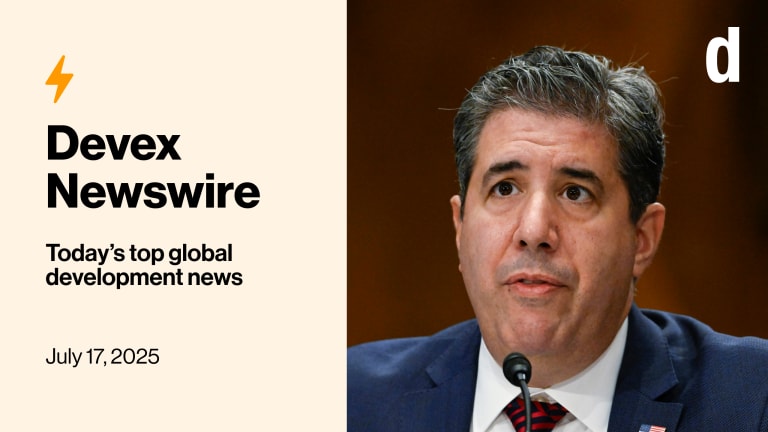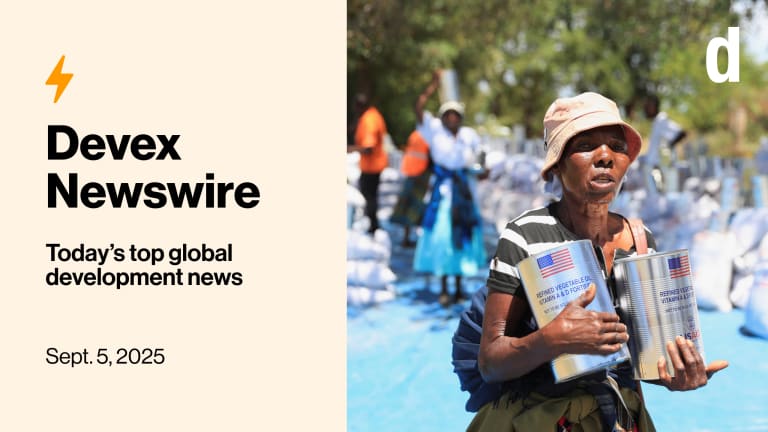Presented by Boehringer Ingelheim

Congressional reauthorization for the landmark U.S. HIV/AIDS initiative known as PEPFAR quietly expires today. It’s a blow, but not a mortal one — although the program still faces an existential reckoning ahead.
Also in today’s edition: The staggering potential death toll of child malnutrition, and what Americans really think of foreign aid.
This is a preview of Newswire
Sign up to this newsletter for an inside look at the biggest stories in global development, in your inbox daily.
+ Two months after the U.S.aid freeze: Millions impacted, USAID in flux. Join our live panel today to discuss the agency’s future, Congressional budget, lawsuits, and next steps for aid organizations. Save your spot now. This event is for Devex Pro members. Not a Pro member yet? Start your 15-day free trial today.
Moment of truth
It’s been a crowning achievement of bipartisan compassion that has saved millions of lives. It’s also on life support.
PEPFAR used to enjoy regular five-year reauthorizations in the U.S. Congress, but last year it got caught up in America’s culture wars over abortion. It managed to eke out a one-year extension, which is all but certain to expire today.
But because the program is written into federal law, “actual permission for the program to exist doesn’t expire,” even if PEPFAR’s authorization does, Katie Coester of the Elizabeth Glaser Pediatric AIDS Foundation tells Devex contributing reporter Andrew Green.
“As long as there is funding appropriated for the program, it can technically and legally continue,” adds Jennifer Kates of KFF.
But take note of that word: technically.
USAID administered the majority of PEPFAR. After the agency’s dismantling, lifesaving programs — specifically those such as PEPFAR — were meant to be exempted, but the process has been riddled with problems, from patchy payments to ongoing bewilderment over which services can continue. For example, some treatments have been granted waivers, but contracts for the transportation of medicines and supplies, such as HIV tests, were canceled, hobbling the effectiveness of treatments.
In Uganda, Enid Kyomuhendo was due for a refill of the antiretroviral drugs that suppress her HIV infection just days after U.S. President Donald Trump’s stop-work order went into effect. The clinic where she gets the treatment was closed.
“I got so worried,” she tells Andrew. “I started taking alcohol. I was thinking that anytime I am going to die. It became this life of hopelessness.”
Two months later, she got her refill but now worries she is resistant to the ARVs — and the test to determine if she is resistant is unavailable.
“The health workers just tell me to take the medicine because they don’t know what is going to happen next,” she says.
Read: Why PEPFAR has bigger problems than reauthorization
Mass exodus
40%
—That’s the percentage of total revenue that UNAIDS no longer can count on because of the USAID pullback. If that weren’t enough, other donors such as France and the United Kingdom are also cutting aid budgets, potentially compounding UNAIDS’ financial woes, my colleague Jenny Lei Ravelo writes.
UNAIDS Executive Director Winnie Byanyima confirms Jenny’s earlier reporting that the agency is looking at restructuring. But Byanyima says UNAIDS is “managing,” noting that they “haven't yet given anybody a pink slip.”
But she admits: “Worst-case scenario is about more reductions from Europe as well as the possibility of zero from the United States.”
Beyond the financial hit that UNAIDS would absorb, it could mean the fight against HIV/AIDS, which is so close to being in the rearview mirror, rears its ugly head again. In fact, if U.S. aid for HIV and AIDS is not restored or not replaced by other funding sources, UNAIDS estimates there will be an additional 6.3 million AIDS-related deaths in the next four years — a tenfold increase from 2023.
Read: UNAIDS faces dicey future as US slashes 40% of its budget
Ideas on the table
Like health, food is another area that a slimmed-down USAID may prioritize. But food assistance has run into many of the same barriers that have hampered the delivery of lifesaving medicines — which is having a deadly effect on malnourished children.
“We know children are dying,” Jeanette Bailey of the International Rescue Committee said at a recent Devex Pro event. “It's probably in the hundreds every day that these kind of disruptions continue. It's in the thousands every month, and by the end of this year, we can anticipate tens of thousands, or even hundreds of thousands, of very young children, toddlers, and babies, who are starving to death, where there should be food available. And where there is food available; it's just not getting to them due to all the supply chain disruptions.”
There’s obviously no silver lining to children dying, but the crisis could present the opportunity to rethink a system that overwhelmingly relies on the U.S.
Mark Moore, CEO of U.S.-based Mana Nutrition, said one longstanding issue with U.S. food aid is that it has been “a self-serving venture.” Much of the world’s supply of ready-to-eat therapeutic food, for example, is made with U.S.-grown ingredients, purchased by the U.S. government, and shipped abroad on U.S. carriers — creating a market for U.S. farmers and companies throughout the entire supply chain. Localizing food production and diversifying supply chains could make the system more immune to political whims.
“Now, I could never say that this is good, because every single life that is lost has made this entire thing bad,” Bailey said. “But the opportunity we have right now is to rewrite this system and to really recognize the flaws.”
Read: Why the US aid freeze could be a moment to reform food aid (Pro)
The court of public opinion
Foreign assistance has always been a convenient political punching bag in the U.S. because of the many misconceptions surrounding it. Once those misconceptions are debunked, however, public opinion shifts dramatically, my colleague Ayenat Mersie writes.
Perhaps the most stubborn myth is that the U.S. expends a ton of total federal spending on foreign assistance — to the tune of 25% in some cases — fueling perceptions that the money would be better spent addressing problems at home. But as aid advocates continually try to hammer home: Aid accounts for less than 1% of federal spending.
When that’s dispelled, most Americans say the U.S. is spending about the right amount on foreign aid — and that shift occurs across party lines, according to a recent survey from KFF.
But once political narratives take hold, they are hard to break. Many conservatives claim USAID is riddled with corruption and waste. Despite their debatable nature, these claims have sunk in: A recent poll for the Financial Times found that almost 60% of respondents agreed that funds set aside for humanitarian causes were “wasted on corruption or administration fees.”
So do Americans really want USAID dismantled? It’s complicated. About half of those surveyed by KFF said eliminating USAID would make the country less safe, but there was a major partisan divide: with over 3 in 4 Democrats believing this to be the case, compared to 1 in 4 Republicans.
Read: Foreign aid is an easy political target. But do Americans want it gone?
Help wanted
Layoffs have swept the aid sector since Trump came to office — but there are still job opportunities, including in the U.S. In fact, we found that despite many firms facing financial hardship, the number of job openings posted in the U.S. has dropped only by around 6% compared to the previous year.
That doesn’t mean it’s a jobs bonanza, but it’s not an employment apocalypse either. At the United Nations, for example, the picture is very mixed. While there have been layoffs at the International Migration Organization and a hiring freeze at other U.N. agencies such as the World Health Organization, other agencies such as UNICEF and the U.N. Development Programme are still actively hiring. U.S.-based foundations such as the Gates Foundation and NGOs such as Samaritan’s Purse are also among those seeking new hires.
My colleagues Genevieve Gregorio and Kristiana Louise Ortega spotlight key global development organizations that are actively recruiting in the United States despite the funding freeze.
Read: Who is still hiring in the US? (Career)
+ Sign up for a Devex Career Account membership today to unlock all our exclusive career resources and get full access to the world’s largest global development job board.
In other news
The U.N. plans to withdraw 30 of its 100 personnel from Gaza this week amid intensified Israeli attacks that have killed hundreds, including U.N. staff. [Al Jazeera]
Kenya is seeking a new IMF loan after the previous agreement was discontinued due to time constraints, with the country’s finance minister, John Mbadi, denying any fallout over unmet targets. [Reuters]
The U.N. and 113 partners are requesting $934.5 million in the first year of their 2025-2026 appeal to assist 1.48 million people in Bangladesh, including Rohingya refugees and host communities. [Reuters via Yahoo News]
Sign up to Newswire for an inside look at the biggest stories in global development.








